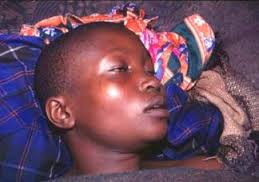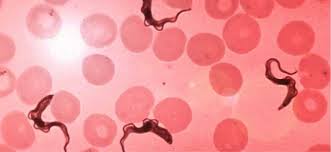African trypanosomiasis symptoms and treatment
Sleeping sickness also called as African trypanosomiasis is caused due to a protozoan parasite called as Trypanosoma brucei gambiense. This disease is only seen in parts of Africa. Tsetse mosquito acts as vector, it transmits the disease. This protozoan infects cattle too. In this post i have explained few things like african trypanosomiasis symptoms and treatment.
While taking blood from a mammalian host, an infected tsetse fly injects the protozoan into skin tissue. From the bite, parasites first enter the lymphatic system and then pass into the bloodstream. Inside the mammalian host, they transform into bloodstream trypomastigotes, and are carried to other sites throughout the body, reach other body fluids (e.g., lymph, spinal fluid), and continue to replicate by binary fission.
A tsetse fly becomes infected with bloodstream trypomastigotes when taking a blood meal on an infected mammalian host. In the fly’s midgut, the parasites transform into procyclic trypomastigotes, multiply by binary fission, leave the midgut, and transform into epimastigotes. The epimastigotes reach the fly’s salivary glands and continue multiplication by binary fission.
The entire life cycle of the fly takes about three weeks. In addition to the bite of the tsetse fly, the disease can be transmitted by:
- Mother-to-child infection: the trypanosome can sometimes cross the placenta and infect the fetus.
- Laboratories: accidental infections, for example, through the handling of blood of an infected person and organ transplantation, although this is uncommon.

- Blood transfusion
- Sexual contact (This may be possible)
African trypanosomiasis Symptoms
- African trypanosomiasis symptoms occur in two stages.
- The first stage, known as the haemolymphatic phase”, is characterized by fever, headaches, joint pains, and itching. Fever is intermittent, with attacks lasting from a day to a week, separated by intervals of a few days to a month or longer. Invasion of the circulatory and lymphatic systems by the parasites is associated with severe swelling of lymph nodes, often to tremendous sizes.
- The second, neurological phase, begins when the parasite invades the central nervous system by passing through the blood–brain barrier. Disruption of the sleep cycle is a leading symptom of this stage and is the one that gave the disease the name ‘sleeping sickness.’ Infected individuals experience a disorganized and fragmented 24-hour rhythm of the sleep-wake cycle, resulting in daytime sleep episodes and nighttime periods of wakefulness.
- Other neurological symptoms include confusion, tremor, general muscle weakness, hemiparesis and paralysis of a limb.
- Parkinson-like movements might arise due to non-specific movement disorders and speech disorders. Individuals may also exhibit psychiatric symptoms such as irritability, psychotic reactions, aggressive behavior, or apathy which can sometimes dominate the clinical diagnosis. Without treatment, the disease is invariably fatal, with progressive mental deterioration leading to coma, systemic organ failure, and death.
Diagnosis
It is diagnosed by blood smear or in the fluid of a lymph node. A lumbar puncture is often needed to tell the  difference between first and second stage disease.
difference between first and second stage disease.
Prevention and treatment
- Prevention of the disease involves screening the population at risk with blood tests for the protozoan.
- Treatment is easier when the disease is detected early and before neurological symptoms occurs. Treatment of the first stage is with the medications pentamidineor suramin.
- Treatment of the second stage involves: eflornithine or a combination of nifurtimox and eflornithine

